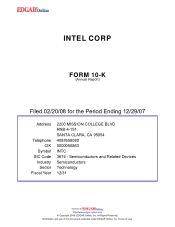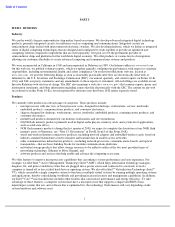Intel 2007 Annual Report Download - page 8
Download and view the complete annual report
Please find page 8 of the 2007 Intel annual report below. You can navigate through the pages in the report by either clicking on the pages listed below, or by using the keyword search tool below to find specific information within the annual report.
Table of Contents
Wired and wireless Internet connectivity products, such as network adapters and embedded wireless cards, are based on
industry-standard technologies used to translate and transmit data in packets across networks. Our wireless connectivity
products are based on either the 802.11 or 802.16 industry standard. The 802.11 communication standard refers to a family of
specifications commonly known as WiFi technology. We also have developed and are developing wireless connectivity
products for both mobile and fixed networks based on the 802.16 industry standard, commonly known as WiMAX, which is
short for Worldwide Interoperability for Microwave Access. WiMAX is a standards-based wireless technology providing
high-speed broadband connectivity that makes it possible to connect users to networks wirelessly, as well as networks to other
networks, up to several miles apart.
Communications infrastructure products include advanced, programmable processors used in networking equipment that
rapidly manage and direct data moving across the Internet and networks. Our modular communications platforms are based on
telecommunications industry standards, such as carrier grade, allowing communications and media services to be managed
independently from the network itself. Unlike proprietary systems platforms, carrier-grade, rack-mount servers based on our
modular communications platforms are standards-based solutions that offer network infrastructure builders flexible, low-cost,
low-power-consumption options for designing their networks.
Below, we discuss our key products and processor technologies, including some key introductions, for our major operating
segments. For a discussion of our strategy, see “Management’s Discussion and Analysis of Financial Condition and Results of
Operation” in Part II, Item 7 of this Form 10-K.
Digital Enterprise Group
The Digital Enterprise Group (DEG)’s products are incorporated into desktop computers, enterprise computing servers,
workstations, a broad range of embedded applications, and other products that help make up the infrastructure for the Internet.
DEG’s products include microprocessors and related chipsets and motherboards designed for the desktop and enterprise
computing market segments; microprocessors, chipsets, and other components for communications infrastructure equipment,
such as network processors, communications boards, and embedded processors; wired connectivity devices; and products for
network and server storage.
Net revenue for the DEG operating segment constituted 53% of our consolidated net revenue in 2007 (56% in 2006 and 65%
in 2005). Revenue from sales of microprocessors within the DEG operating segment represented 40% of consolidated net
revenue in 2007 (41% in 2006 and 50% in 2005).
Desktop Market Segment
Our current desktop microprocessor offerings include the:
Most of these microprocessors are based on the Intel Core microarchitecture. Intel Core microarchitecture-based processors
are designed for energy-efficient performance and are manufactured using either 65- or 45-nanometer (nm) process
technology. We offer microprocessors at a variety of price/performance points: from the high-
end Intel Core 2 Quad processor
with four processor cores, designed for processor-intensive
tasks in demanding multitasking environments, to the Intel Celeron
processor designed to provide value, quality, and reliability for basic computing needs. The related chipsets for our desktop
microprocessor offerings primarily include the Intel
®
945G Chipset, the Intel
®
Q965 Chipset, and Intel
®
3 Series Chipsets.
We also offer processor technologies based on our microprocessors, chipsets, and motherboard products that are optimized for
the desktop market segment. For business desktop PCs, we offer the Intel
®
Core
TM
2 processor with vPro
TM
technology,
which is designed to provide increased security and manageability, energy-
efficient performance, and lower cost of ownership.
3
•
Intel
®
Core
TM
2 Quad processor
•
Intel
®
Celeron
®
Dual
-
Core
processor
•
Intel
®
Core
TM
2 Duo processor
•
Intel
®
Celeron
®
processor
•
Intel
®
Pentium
®
Dual
-
Core processor





















